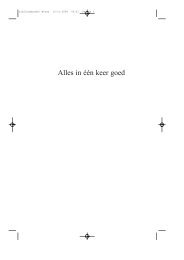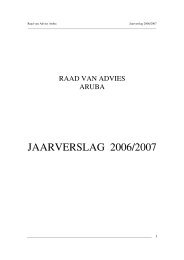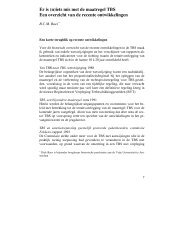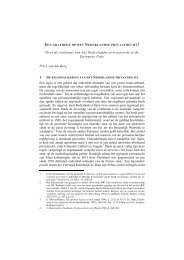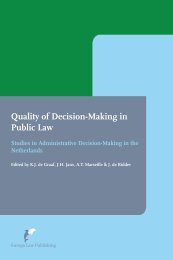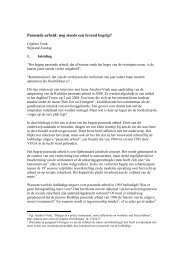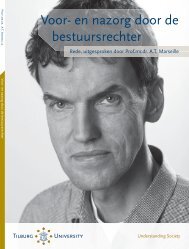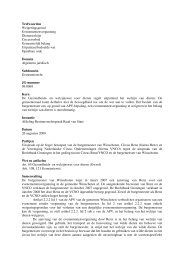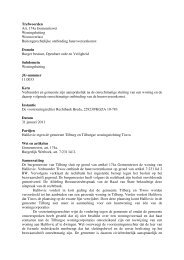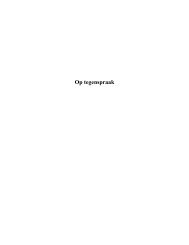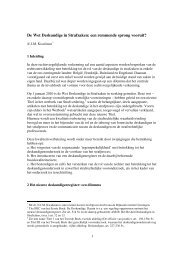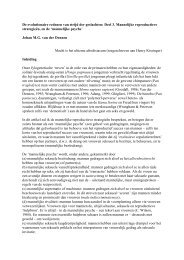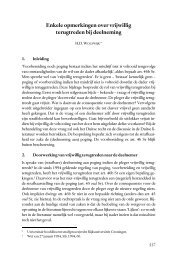Evaluatie embryowet - Rijksuniversiteit Groningen
Evaluatie embryowet - Rijksuniversiteit Groningen
Evaluatie embryowet - Rijksuniversiteit Groningen
You also want an ePaper? Increase the reach of your titles
YUMPU automatically turns print PDFs into web optimized ePapers that Google loves.
scientific research involving pregnant women in the relevant Additional Protocol to the CHRB. One<br />
might consider extending the possibilities for therapeutic research and allowing certain forms of nontherapeutic<br />
research that pose little or no risk to the foetus (both subject to strict conditions and central<br />
review).<br />
Prohibited procedures<br />
Section 24 (a) contains the ban on creating and using an embryo specifically for scientific research<br />
and purposes other than the establishment of a pregnancy, which is ultimately to be repealed. The<br />
study findings reveal that the ban is today already acting as a barrier to the advancement of several<br />
avenues of research, namely research into certain innovations in reproductive medicine and basic research<br />
in several specific areas. Eventually, the ban may also act as a barrier to scientific research into<br />
cell therapy (nuclear transplantation, direct reprogramming) and pharmacotherapy. A specific problem<br />
arising in practice concerns the training of staff to carry out particular procedures where it is necessary<br />
to create an embryo that is subsequently lost.<br />
In Europe, legislation has become less restrictive with regard to embryo research, even where embryos<br />
are being created specifically for scientific research. Two of the reasons why Parliament, at the<br />
time, gave the ban a provisional character – anticipating scientific developments and shifting views in<br />
neighbouring countries – have been realised. Moreover, there is no evidence of developments that<br />
would necessitate either postponing the lifting of the ban or modifying the Act on this point. Through<br />
the inclusion of the requisite safeguards and conditions, the Act has already been geared to the situation<br />
following the lifting of the ban. We believe that the Government should implement the Act in a<br />
timely way and place a Royal Decree before Parliament to repeal sub-section (a) of Section 24.<br />
The Act mentions a number of research areas for which embryos might be specifically created in future<br />
(i.e. after the ban has been lifted). The study findings indicate that this restrictive list may have<br />
the effect of standing in the way of certain highly promising avenues of research. Essentially, this<br />
means research that might, in time, afford greater insight into certain serious diseases and promote<br />
better treatments and, possibly, future research into pharmacotherapy that is tailored to individual<br />
patients.<br />
The conclusion drawn is that statutory regulation may act as a barrier to scientific progress in the<br />
treatment of certain significant health problems. It would be advisable to consider broadening these<br />
research areas. The scientific research that would then be permitted should, however, remain within<br />
the realm of medicine.<br />
According to the evaluation study, the use (or further use) of gametes or embryos for the purposes of<br />
quality assurance or education is unlawful and also punishable. Use for educational purposes is, however,<br />
permitted in the case of stem cells from surplus human embryos. The prohibited applications referred<br />
to here appear to be widespread in practice and also important.<br />
The conclusion drawn is that this is a bottleneck. It would be advisable to adapt the Act in such a way<br />
that quality improvement and education are not unnecessarily impeded and that can be done what is<br />
necessary in order to introduce new methods and techniques carefully into clinical practice.<br />
21



